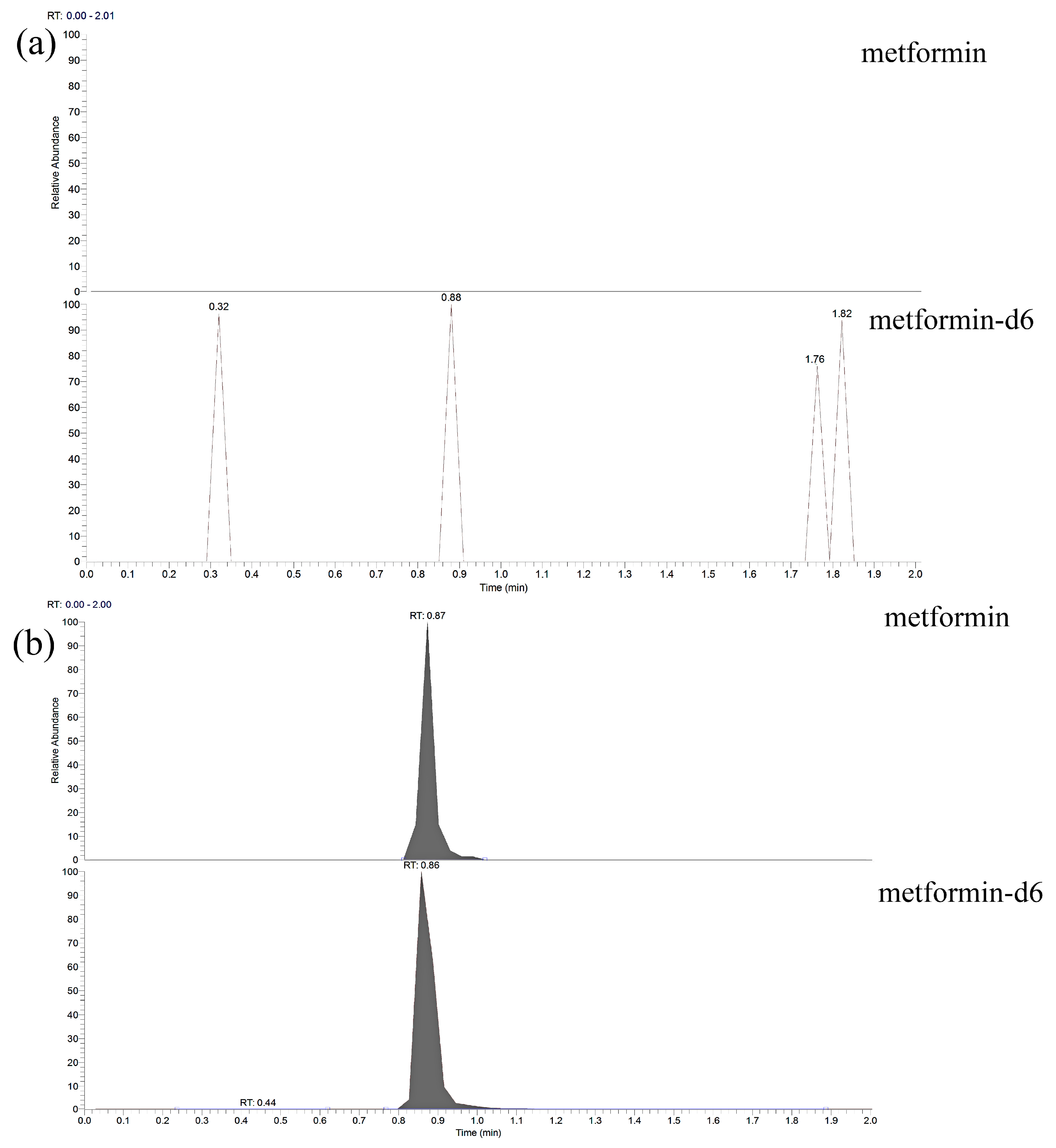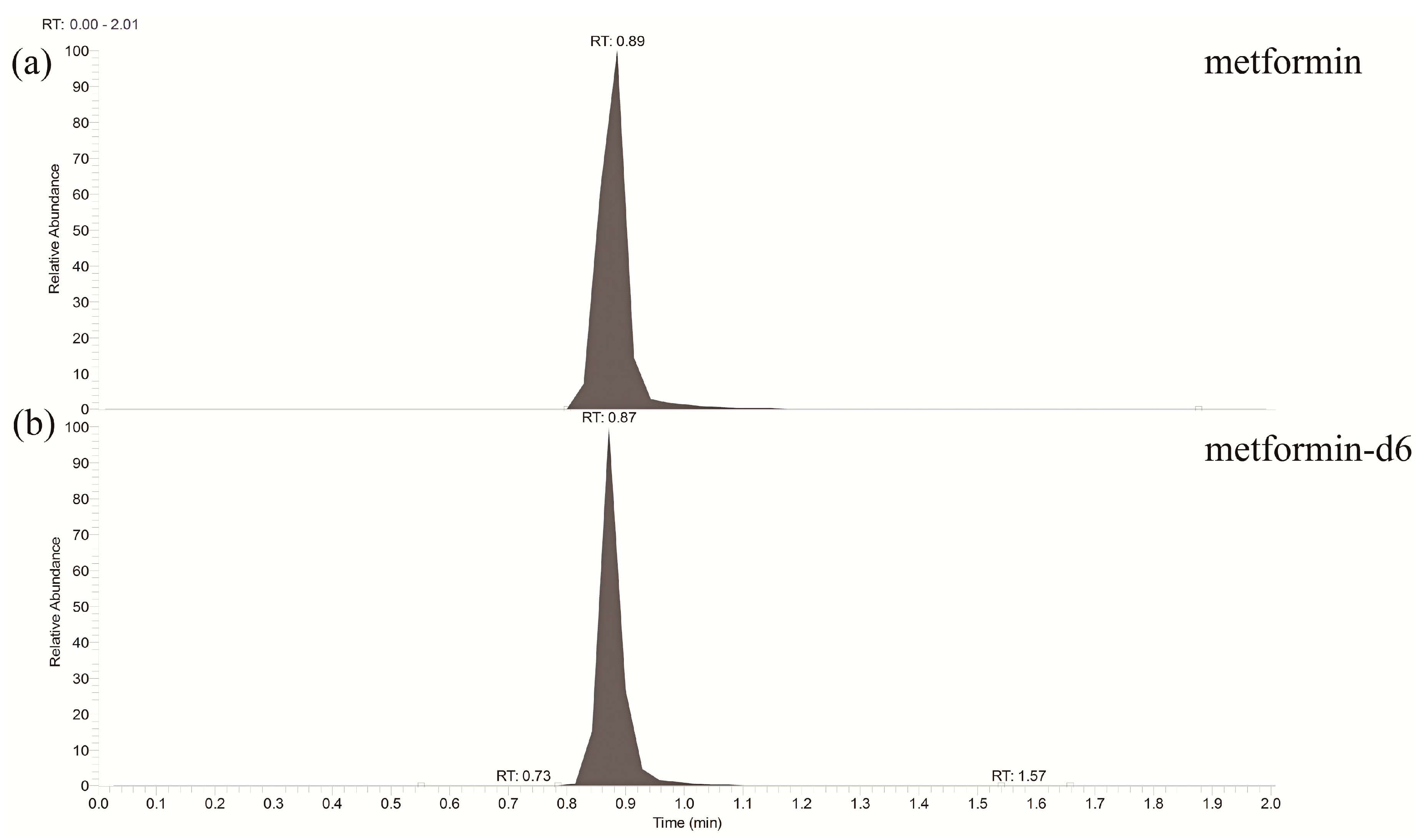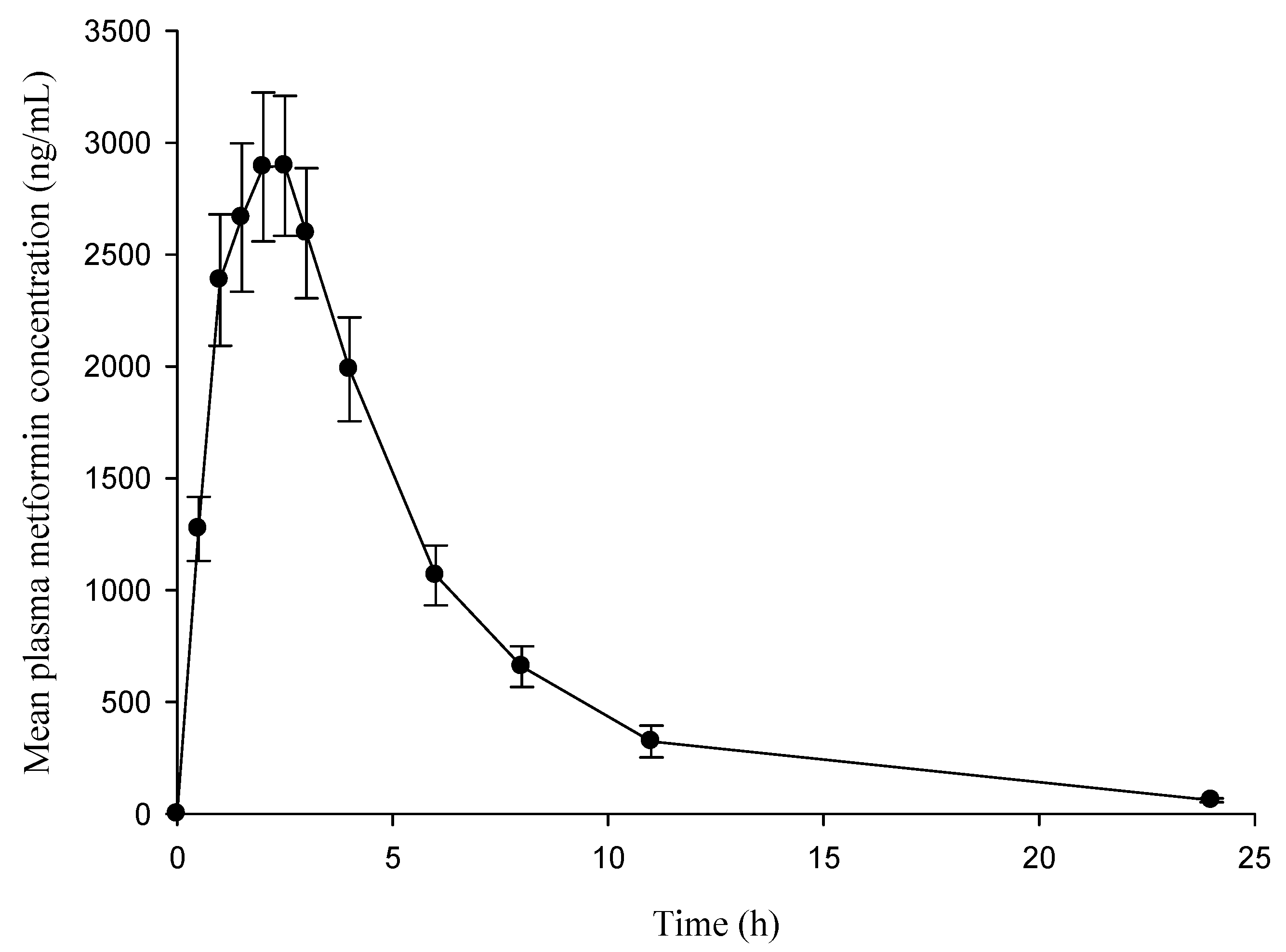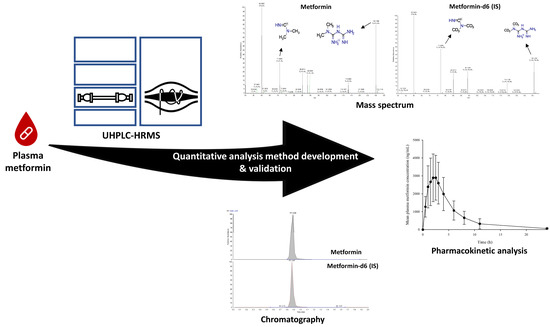Bioanalytical Method Using Ultra-High-Performance Liquid Chromatography Coupled with High-Resolution Mass Spectrometry (UHPL-CHRMS) for the Detection of Metformin in Human Plasma
Abstract
1. Introduction
2. Results
2.1. Method Development
2.2. Linearity and Sensitivity
2.3. Accuracy and Precision
2.4. Selectivity and Matrix Effects
2.5. Stability and Recovery
2.6. Application of the Method in Human Plasma Samples
3. Discussion
4. Materials and Methods
4.1. Chemicals, Reagents, and Materials
4.2. Liquid Chromatography and Mass Spectrometric Conditions
4.3. Standard and Quality Control Preparation
4.4. Sample Preparation
4.5. Bioanalytical Method Validation
4.5.1. Linearity and Sensitivity
4.5.2. Accuracy and Precision
4.5.3. Selectivity and Matrix Effect
4.5.4. Stability and Recovery
4.6. Application of the Method in Human Plasma Samples
5. Conclusions
Author Contributions
Funding
Conflicts of Interest
References
- Winer, N.; Sowers, J.R. Epidemiology of diabetes. Clin. Pharmacol. 2004, 44, 397–405. [Google Scholar] [CrossRef] [PubMed]
- Weggemans, R.M.; Backx, F.J.; Borghouts, L.; Chinapaw, M.; Hopman, M.T.; Koster, A.; Kremers, S.; van Loon, L.J.; May, A.; Mosterd, A. The 2017 Dutch physical activity guidelines. Int. J. Behav. Nutr. Phys. Act. 2018, 15, 58. [Google Scholar] [CrossRef] [PubMed]
- Artasensi, A.; Pedretti, A.; Vistoli, G.; Fumagalli, L. Type 2 Diabetes Mellitus: A Review of Multi-Target Drugs. Molecules 2020, 25, 1987. [Google Scholar] [CrossRef] [PubMed]
- Rena, G.; Hardie, D.G.; Pearson, E.R. The mechanisms of action of metformin. Diabetologia 2017, 60, 1577–1585. [Google Scholar] [CrossRef] [PubMed]
- Uçaktürk, E. The development and validation of a gas chromatography-mass spectrometry method for the determination of metformin in human plasma. Anal. Methods 2013, 5, 4723–4730. [Google Scholar] [CrossRef]
- Antonopoulos, N.; Machairas, G.; Migias, G.; Vonaparti, A.; Brakoulia, V.; Pistos, C.; Gennimata, D.; Panderi, I. Hydrophilic Interaction Liquid Chromatography-Electrospray Ionization Mass Spectrometry for Therapeutic Drug Monitoring of Metformin and Rosuvastatin in Human Plasma. Molecules 2018, 23, 1548. [Google Scholar] [CrossRef]
- Chhetri, H.P.; Thapa, P.; Van Schepdael, A. Simple HPLC-UV method for the quantification of metformin in human plasma with one step protein precipitation. Saudi. Pharm. J. 2014, 22, 483–487. [Google Scholar] [CrossRef]
- Shah, P.A.; Shrivastav, P.S.; Vanol, P.G.; Sanyal, M. Mechanistic study for the simultaneous determination of metformin and teneligliptin in human plasma using hydrophilic interaction liquid chromatography—MS/MS. Bioanalysis 2018, 10, 475–488. [Google Scholar] [CrossRef]
- Mowaka, S.; Elkady, E.F.; Elmazar, M.M.; Ayoub, B.M. Enhanced LC-MS/MS determination of alogliptin and metformin in plasma: Application to a pharmacokinetic study. Microchem. J. 2017, 130, 360–365. [Google Scholar] [CrossRef]
- Mistri, H.N.; Jangid, A.G.; Shrivastav, P.S. Liquid chromatography tandem mass spectrometry method for simultaneous determination of antidiabetic drugs metformin and glyburide in human plasma. J. Pharm. Biomed. Anal. 2007, 45, 97–106. [Google Scholar] [CrossRef]
- Bonde, S.; Bhadane, R.; Gaikwad, A.; Katale, D.; Gavali, S.; Narendiran, A. A simple and sensitive method for determination of metformin and sitagliptin in human plasma using liquid chromatography and tandem mass spectrometry. Int. J. Pharm. Pharm. Sci. 2013, 5, 463–470. [Google Scholar]
- Bateman, K.P.; Kellmann, M.; Muenster, H.; Papp, R.; Taylor, L. Quantitative-qualitative data acquisition using a benchtop Orbitrap mass spectrometer. J. Am. Soc. Mass Spectrom. 2009, 20, 1441–1450. [Google Scholar] [CrossRef] [PubMed]
- Fedorova, G.; Randak, T.; Lindberg, R.H.; Grabic, R. Comparison of the quantitative performance of a Q-Exactive high-resolution mass spectrometer with that of a triple quadrupole tandem mass spectrometer for the analysis of illicit drugs in wastewater. Rapid Commun. Mass Spectrom. 2013, 27, 1751–1762. [Google Scholar] [CrossRef] [PubMed]
- Wang, J.; Chow, W.; Leung, D.; Chang, J. Application of ultrahigh-performance liquid chromatography and electrospray ionization quadrupole orbitrap high-resolution mass spectrometry for determination of 166 pesticides in fruits and vegetables. J. Agric. Food Chem. 2012, 60, 12088–12104. [Google Scholar] [CrossRef] [PubMed]
- Glossmann, H.H.; Lutz, O.M. Pharmacology of metformin–An update. Eur. J. Pharmacol. 2019, 865, 172782. [Google Scholar] [CrossRef] [PubMed]
- Fachi, M.M.; Cerqueira, L.B.; Leonart, L.P.; Francisco, T.M.G.d.; Pontarolo, R. Simultaneous quantification of antidiabetic agents in human plasma by a UPLC-QToF-MS method. PLoS ONE 2016, 11, e0167107. [Google Scholar] [CrossRef] [PubMed]
- Hu, Q.; Noll, R.; Li, H.M.A.; Hardman, M.; Cooks, R.G. J. Mass Spectrom 2005, 40, 430–443. [CrossRef]
- Solliec, M.; Roy-Lachapelle, A.; Sauvé, S. Quantitative performance of liquid chromatography coupled to Q-Exactive high resolution mass spectrometry (HRMS) for the analysis of tetracyclines in a complex matrix. Anal. Chim. Acta 2015, 853, 415–424. [Google Scholar] [CrossRef]
- Shu, Y.; Brown, C.; Castro, R.; Shi, R.; Lin, E.; Owen, R.; Sheardown, S.; Yue, L.; Burchard, E.; Brett, C. Effect of genetic variation in the organic cation transporter 1, OCT1, on metformin pharmacokinetics. Clin. Pharmacol. Ther. 2008, 83, 273–280. [Google Scholar] [CrossRef]
- Chen, X.; Gu, Q.; Qiu, F.; Zhong, D. Rapid determination of metformin in human plasma by liquid chromatography− tandem mass spectrometry method. J. Chromatogr. B 2004, 802, 377–381. [Google Scholar] [CrossRef]
- Wang, Y.; Tang, Y.; Gu, J.; Fawcett, J.P.; Bai, X. Rapid and sensitive liquid chromatography–tandem mass spectrometric method for the quantitation of metformin in human plasma. J. Chromatogr. B 2004, 808, 215–219. [Google Scholar] [CrossRef] [PubMed]
- Food and Drug Administration. Bioanalytical Method Validation Guidance for Industry. Available online: https://www.fda.gov/media/70858/download (accessed on 26 September 2020).
- Guideline on Bioanalytical Method Validation. Available online: https://www.mfds.go.kr/brd/m_210/down.do?brd_id=data0010&seq=13054&data_tp=A&file_seq=1 (accessed on 26 September 2020).
Sample Availability: Samples of the compounds (metformin and metformin-d6) are available from the authors. |




| Parameter | Value |
|---|---|
| Linearity range (ng/mL) | 5–2000 |
| Correlation coefficient | ≥0.9980 |
| Intercept a | 0.0005 ± 0.00002 |
| Slope a | 0.0004 ± 0.0003 |
| LLOQ (ng/mL) | 5 |
| Parameter | LLOQ (5 ng/mL) | LQC (15 ng/mL) | MQC (150 ng/mL) | HQC (1600 ng/mL) |
|---|---|---|---|---|
| Within-run accuracy (%) | 98.22 | 91.13 | 105.25 | 93.74 |
| Between-run accuracy (%) | 106.49 | 94.14 | 100.51 | 97.56 |
| Within-run precision CV (%) a | 8.57 | 3.89 | 8.19 | 1.35 |
| Between-run precision CV (%) a | 13.46 | 6.61 | 6.72 | 6.72 |
| Number | Selectivity | Matrix Effect | ||
|---|---|---|---|---|
| Analyte | IS | LQC (15 ng/mL) | HQC (1600 ng/mL) | |
| 1 | 0 | 0.033 | 116.1 | 89.4 |
| 2 | 0 | 0 | 92.3 | 96.7 |
| 3 | 5.78 | 0 | 105.7 | 113.2 |
| 4 | 8.46 | 0 | 101.5 | 101.3 |
| 5 | 7.32 | 0.033 | 96.6 | 114.8 |
| 6 | 3.17 | 0 | 87.8 | 85.7 |
| Mean ± SD | - | - | 100.0 ± 10.1 | 100.0 ± 12.3 |
| CV (%) a | - | - | 10.1 | 12.3 |
| LQC (15 ng/mL) | HQC (1600 ng/mL) | |
|---|---|---|
| % change | ||
| Autosampler for 24 h | 5.00 | 13.74 |
| One freeze-thaw cycle | 7.46 | 8.76 |
| Three freeze-thaw cycles | 2.95 | −9.49 |
| Plasma at room temperature for 6 h | 13.33 | 15.10 |
| Stock at room temperature for 6 h | 14.19 | 3.03 |
| Parameter | Value | |
|---|---|---|
| Mean | SD | |
| Cmax (ng/mL) | 3187.6 | 1316.2 |
| Tmax (h) | 1.97 | [1.00, 3.02] a |
| AUClast (ng·h/mL) | 18474.6 | 8589.5 |
© 2020 by the authors. Licensee MDPI, Basel, Switzerland. This article is an open access article distributed under the terms and conditions of the Creative Commons Attribution (CC BY) license (http://creativecommons.org/licenses/by/4.0/).
Share and Cite
Kang, Y.-J.; Jeong, H.-C.; Kim, T.-E.; Shin, K.-H. Bioanalytical Method Using Ultra-High-Performance Liquid Chromatography Coupled with High-Resolution Mass Spectrometry (UHPL-CHRMS) for the Detection of Metformin in Human Plasma. Molecules 2020, 25, 4625. https://doi.org/10.3390/molecules25204625
Kang Y-J, Jeong H-C, Kim T-E, Shin K-H. Bioanalytical Method Using Ultra-High-Performance Liquid Chromatography Coupled with High-Resolution Mass Spectrometry (UHPL-CHRMS) for the Detection of Metformin in Human Plasma. Molecules. 2020; 25(20):4625. https://doi.org/10.3390/molecules25204625
Chicago/Turabian StyleKang, Ye-Ji, Hyeon-Cheol Jeong, Tae-Eun Kim, and Kwang-Hee Shin. 2020. "Bioanalytical Method Using Ultra-High-Performance Liquid Chromatography Coupled with High-Resolution Mass Spectrometry (UHPL-CHRMS) for the Detection of Metformin in Human Plasma" Molecules 25, no. 20: 4625. https://doi.org/10.3390/molecules25204625
APA StyleKang, Y.-J., Jeong, H.-C., Kim, T.-E., & Shin, K.-H. (2020). Bioanalytical Method Using Ultra-High-Performance Liquid Chromatography Coupled with High-Resolution Mass Spectrometry (UHPL-CHRMS) for the Detection of Metformin in Human Plasma. Molecules, 25(20), 4625. https://doi.org/10.3390/molecules25204625







